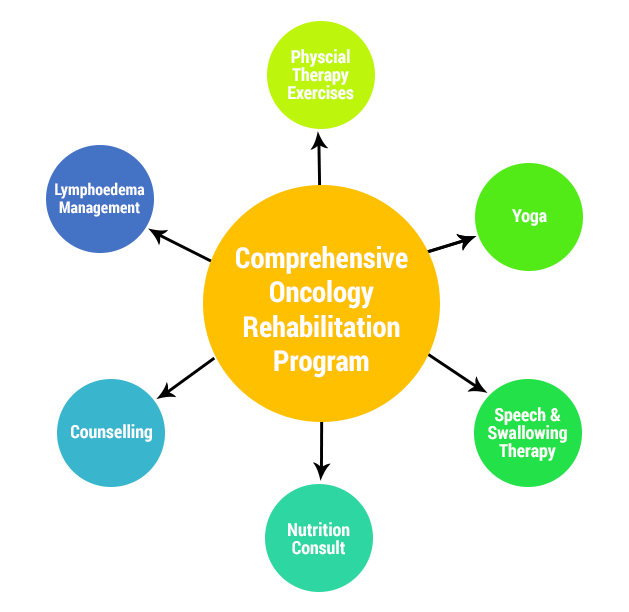What is Oncology (Cancer) Rehabilitation?
It’s a program which helps a person with cancer to obtain maximum physical, social, psychological, and vocational functioning within the limits imposed by disease and its treatment
Who would benefit from it?
Any cancer patient who is currently on treatment or has already finished with the treatment.
What are the goals of the program?
Research studies by American Cancer Society and American College of Sports Medicine have shown that physical exercises help to improve the quality of life in cancer patients by positively influencing physical,
functional and psychosocial well-being. Exercises also reduce perception of fatigue which is a major concern related to cancer therapy. In addition, regular exercises improve effectiveness of radiation and chemotherapy.
The Rehab Team

What does the program consist of?

How frequently should I visit?
You will need to visit the hospital at least 3-4 days a week for therapy, which will be tailor-made for individual patient.
A. Physical Therapy Exercises:
They are divided in 3 parts:
Cancer specific exercises are focused on the area/ body part which is affected by cancer with an aim to relieve pain, improve mobility and build up strength.
Aerobic exercises like walking on the treadmill, cycling or cross trainer are prescribed after assessing your baseline capacity. They help in maintaining or improving your capacity further and reduce fatigue levels.
Strength training to build up strength and endurance of various muscle groups of your body. This is done using weight cuffs, dumbbells, elastic thera-bands and pneumatic machines.
B. Exercises for lymphedema or manual lymphatic drainage (MLD)
Exercises to prevent or drain lymphedema are specific set of exercises which are necessary for the patient who have developed or is at risk of developing swelling in arm or leg after surgery or radiation.
In case of excessive swelling, manual lymphatic drainage (MLD) and/or MLLB (multi-layer lymphedema bandaging) is given as needed with or without the use of special machines like Lympha-tron or Deep Oscillation Unit.
C. Speech Therapy:
Swallowing & Speech problems can occur after cancerous sections of the mouth, throat or larynx (voice box) are surgically removed and during/after radiation therapy.
Assessment and diagnosis of speech / swallowing problems is done using various objective and subjective methods (e.g. FEES-fiberoptic endoscopic evaluation of swallowing, Acoustic Analysis of voice) by a therapist. If the individual requires treatment,
the speech-language & swallowing therapist can work with him or her to improve these functions. Therapy may include:
C. Yoga:
Cancer and its treatment are associated with a high degree of stress, anxiety and depression. Yoga, in the form of breathing exercises, meditation and aasanas, provides relaxation and also improves mental and spiritual wellbeing.
D. Nutrition:
Our team of dieticians will help you with a diet plan and all your queries pertaining to diet.
E. Counselling:
Psychologist provides much needed mental and emotional support to the patient and the care-givers with a goal to reduce mental stress. This is done by helping them towards acceptance of the disease and preparing them for the treatment and its side effects. During the sessions, the psychologist guides the patient and the care-giver to develop skills to adapt to the altered lifestyle and integrate back to the society without fear of stigma.
We held multiple cancer support group meetings for the survivor and the care-givers. The meetings are promoted to share the experiences. The purpose of the group is to promote communication among members and also provide information regarding dealing with cancer & related problems with a view to improve their quality of life.
“Never be ashamed of a scar. It simply means you were stronger than whatever tried to hurt you.”
